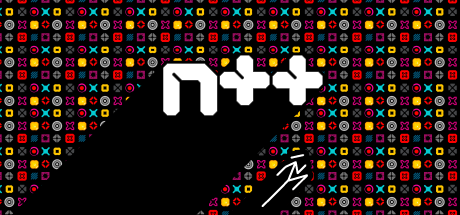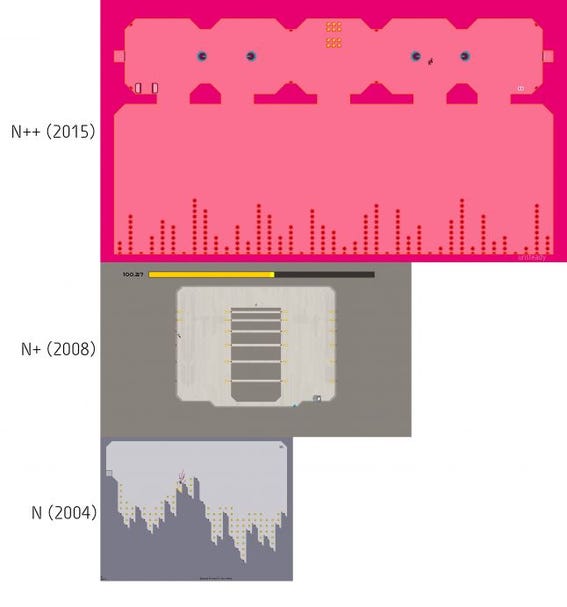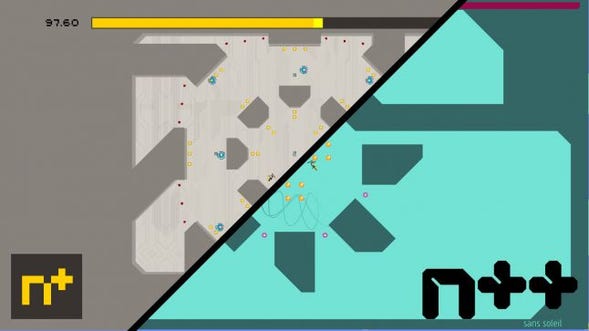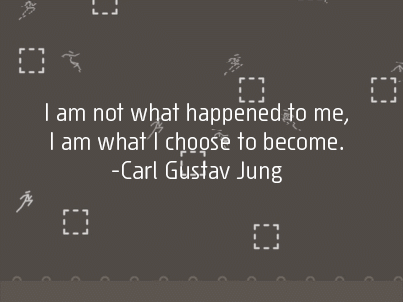
Featured Blog | This community-written post highlights the best of what the game industry has to offer. Read more like it on the Game Developer Blogs.
We're Metanet Software (Mare Sheppard and Raigan Burns), and we have been making games since 2001.
We just launched N++ on Steam, completing the twelve-year journey that began with the free Flash version of N back in 2004. This is a retrospective.


Hi! we're Mare and Raigan, aka Metanet Software: developers of the minimalist momentum-based platformers N/N+/N++.
Yesterday, we launched N++ (on PC). This sequel is returning to the platform where its grandfather was born way back in 2004. It makes a certain kind of sense for us to talk about it in terms of generations in a family, since it sometimes feels like a large part of ours.
Over the years, maybe only half of our time has been spent on this series. We've worked on many internal projects and prototypes, as well as some contract work in between N, N+ and N++, but we found we kept returning to the series. It started as a first draft back in 2004 with N, but we really wanted to perfect and finalize it.
Happily, we finally feel like we've achieved that, and we wanted to share that story; we don't quite have enough distance/time/perspective to do a proper N++ postmortem yet, so instead we're going to give a sort of retrospective on the gestation of an idea across more than a decade, and how that has panned out.

Back up a bit, what are you talking about?
First off, we should introduce the series for those of you who aren't familar with it. We'll start off by describing the core aspects that are common across N, N+ and N++, and then later we'll go into more detail on what sets each game apart from the previous ones in the series.
N, N+ and N++ are a series of momentum-based platformers. They're a bit different from most platformers in that the basic running and jumping is performative, challenging and not trivial: the ninja you're controlling has a lot of inertia, and learning how to control it is quite nuanced -- a bit like Trials if it was a platformer, or a driving game, where you're constantly adjusting your momentum -- and much less like conventional platformers.
The game takes place all on a single screen, and is an old-school action platformer with a puzzle twist and some modern flourishes. It was deliberately designed to be extremely fair, since it's so challenging; this way, players know where they went wrong and are inspired to try again, and when they're successful, they know it's because of their skills, which is very satisfying.
The N series is all about arcade style minimalism, where everything is purposeful and directed, and there isn't any filler. The focus is on the gameplay, so everything else in the game is pared back, to put the spotlight on the way the game feels to play: for example, the graphics are minimalist and highly functional, rather than being decorative; the AI is predictable and simple a-la Pac Man; and the UI is clear, concise and relatively uncluttered. As a player, you never have to give much thought to that, you can read all the on-screen info you need at a glance, so your attention can be reserved for the gameplay.
The series features a few "weird" ideas or anti-conventions that are (or, were back in 2004) unusual in a platformer: there are no lives, and the player character cannot attack enemies (it's more of a "pure" platformer than a mash-up). The player character takes fall damage (which may have been subconciously inspired by Dark Castle -- we did love that game; the implementation is *definitely* inspired by Quake), and we combined a sort of semi-slow-mo feel with moon gravity and inerta to make controlling the character feel really unique.
(Way back in 2004, no-lives/fast-retry just seemed like an obvious evolution for arcade-style games on a PC, and in fact we're pretty sure we remember being inspired by reading some polemic about how anachronistic the concept of "lives" was in post-arcade games.. sadly it's lost in the mists of time.)
Crucially, the game is as much about figuring out a winning route as it is about executing it -- it's not a twitch timing challenge sort of game, nor is it a death counter: it's much looser and more fluid, more about improv than memorization, with each level being a little bespoke arena to dance in.

A brief history of N
Way back in 2001, the game industry was pretty different than it is today. We were in university (where we met), learning to program and playing around on our own time in Flash, and we started experimenting with the little pieces that would eventually become our "ninja game". We made some basic AI, learned about collision detection, and generally just tried making a whole lot of little things, not thinking about a design or project yet.
We were among the first game developers in Toronto, and it was pretty difficult at times, until we met other intrepid developers like Queasy Games (and later, Capy), who really inspired us: they'd made so many real games already, and gave us an idea of some directions we could take.
So in 2004, we released the first version of N, v1.2, built entirely in Flash (AS1). It was constructed in 6 weeks using those little bits and pieces we'd experimented with -- 6 weeks sounds short, but really it was built on 3 years of experimentation and learning. We then supported it after that by updating it and adding features in our spare time over the next 2 years, as email with feedback from players trickled in.
We were pretty into the scratchware manifesto back then, and were somewhat more idealistic and arrogant (ah, youth!), and that influenced some of the decisions we made while putting N together. We made it in part to push back against the trend of casual games that were then becoming popular, because we loved skill-based games and wanted to help ensure that some balance remained in what seemed like a tidal wave of vacant, vapid rewards.
We also wanted to demonstrate that you could make "real games" in Flash, not just websites or webgames (which were not very highly regarded at the time). We were very inspired by freeware, and borrowed elements that we loved from the games we were playing at the time (like Soldat, Super Bubble Blob, Puchiwara no Bouken, and Zone Runner); we really wanted to contribute and help keep the freeware movement alive. There's certainly a raw/scrappy/punk feel to N's core. Hell, we named it "N" because it was both perfectly descriptive (for a minimalist ninja platformer) but also a bit weird.
We continued to develop N on and off over the years, and rewrote it in 2012 to modernize it, and also to make N++ easier to develop. The original 2004 code was written in a rush, and then we hacked at and added to it for 2 years, as you do, until it was a gigantic mess. There were a few features we couldn't realistically add without cleaning things up, and judging by the state it was in, it seemed easier to just rewrite it than try to clean it up! This is when we moved from AS1 to AS3, creating a more modern and better codebase -- happily, technology had improved to the point where N could finally run in-browser as well.
N is still a little rough around the edges, but it's fun, and it was a reasonably well-executed sketch of our vision for our ninja game.
Dreaming bigger

Over time N developed a rabid fan-base. One of the people who liked it worked at Microsoft, and managed to convince other people there that it would be a good fit for the then-new XBLA platform.
So in 2007-2008, we made N+ for XBLA with the help of Slick Entertainment. (There were also DS and PSP versions made by another team and Atari, but we will skip over them because we were less happy with how they came out). For N+, we made levels and directed the project -- it was our first time doing this, and we learned a LOT. We were trying to simultaneously work on a new game, Robotology (we don't recommend this approach!), so Slick was tasked with porting our N code and took care of a lot of the development process; for example, designing the UI and graphics: we sent reference material and provided feedback on the gameplay and overall look and feel, but they handled a lot of things on their own -- and with panache ;)
The goal when we decided to make N+ was to bring a bigger and more fully-featured version of N to a new audience on consoles. The impetus behind the "+" was to add enough to differentiate N+ from N, so we added new game modes, updated graphics and a smattering of new enemies. The release of N+ went very well, and we were surprised by how well-recieved it was by console gamers (this was early in XBLA when indie games were not yet common). Since then, our main criticism of N+ was that it hasn't aged well, or rather: it hadn't changed, but we had grown to see all of the missed opportunities for improvement.
The Road to N++

And that brings us to N++, which we worked on from 2013-2016, and which is now out on PS4 and Steam!
The goal of this project was to leverage our 10+ years of thought and consideration over the course of the series, and make the very last N game we're ever going to make, because we'll never be able to top it. Honestly, it turned out even better than we ever could have hoped.. but took a long time to get to that point, and it was a road fraught with peril.
For N++, we wanted to collaborate with a (print) graphic designer -- someone who mainly worked outside of games, in order to make the minimal aesthetic really special. This was the first time we'd attempted anything like that, and it was a bit rough. It was very hard to find someone who shared our vision and understood how to translate their knowledge of print graphic design into the games world. We lost a lot of time at the start of the project working with a different designer than the one we ultimately went with.
The first designer was very well-respected in their field and does really amazing work, but as more of an "artist" graphic designer, they indicated that they considered it an insult when we asked for modifications to their work. Because games require a lot of adjustment and back and forth, it became apparant that the relationship would never really work, and also that designs that work in static layouts may not translate when things are in motion.
The whole process was very daunting, and challenging: although they are both creative industries, we had such a different perspective than this graphic designer that it made us question our direction and needs, and really think about what collaboration meant. In hindsight it was really helpful to have problems with our first designer, since it made us question ourselves, and so really helped crystalize in our minds exactly what we were trying to do.
We took that new idea to another graphic designer whose work we have admired for years, MASA, and things worked really well. It was so rewarding, perhaps even more so because we had been shaken up so recently, and so fundamentally. MASA pushed us even further out of our comfort zone and really helped broaden our horizons and run with things. For example, although we were planning to add a bit of new colour to N++ beyond the series' signature gray palette, MASA showed us concepts with lots of bright, exuberant colours, which was at first terrifying, but after that, eye-opening and exhilirating. We got so enthusiastic about colour that before we knew it, we had made over 50 colour schemes!
Working with MASA over the summer of 2013, we ended up with solid concept and overall look for the game and UI that we then fleshed out and applied to the rest. The concept was something that was still minimal and stylized, and referenced the previous games in the series, but which was more accessible to players: the grayscale palette of the N series has always seemed very cold to people, and like it keeps them at arms length. Adding colour and style really warmed the game up and made it more inviting, which complemented the new tweaks to the game's design well.
The UI was a huge task: although it seems like such a simple game, there is a tremendous amount of info and details to present to players, and it took a long time to figure out how to make the UI clear, detailed and not too overwhelming.

So what else is new?
Another big new part of N++ is the massive licensed soundtrack.
At the start of N++, we were contemplating having no music, thinking the game doesn't really need it, and worrying about wasting time not being able to find anything that fits. But with the explosion of colours and levels, we realized there was a real opportunity to expand things a bit more, and to push outside of our comfort zone yet again.
This was very daunting at the start, and we were fortunate to get lots of help and advice from Alex Jansen, who worked with a huge roster of different artists for Loud on Planet X , and Simon Bennett from Roll7 who made OlliOlli, an *amazing* game with a killer soundtrack we were really impressed with. They helped explain the inscrutable music industry terms that we would have to face while negotiating licensing deals -- we definitely would not have been able to tackle a 63-song soundtrack without their generous support! It's this sort of community spirit that makes being an indie developer so worthwhile. :)
Even armed with Alex and Simon's wisdom, the licensing process was a huge pain; we tried to batch/group things (liscensing multiple tracks from the same artist or label if possible -- really crucial and smart advice that made this crazy endeavour possible), but we still ended up negotiating 43 contracts (and sending 43 wire transfers, etc.) on top of regular dev work. Still, we think it was the right choice for N++: the music really adds a sense of atmosphere to the game, and we've heard lots of positive feedback about soundtrack, so we know people seem to be digging it, which makes it all the more worthwhile.
Our process for picking music was to browse Soundcloud and Bandcamp on evenings/weekends, then compile a list of hundreds of candidate songs. We would vet candidates by playing the game while listening, and both of us voted on what felt right or felt like it worked. In the end, we found 63 tracks that worked really nicely, hitting a good balance between energizing and upbeat tracks, and low-key background ones; we tried to ensure a wide range of styles and moods, to suit the huge dynamic range of the levels.
Speaking of which, another big addition to N++ is the levels. Initially we intended for N++ to be closer to N+ in scope (i.e 500 levels, about 10 hours of gameplay), but we got so excited about how the project was turning out, we had more and more ideas and really felt joy seeing them come to life. Plus, since our overarching goal of N++ was to make it the very last game in the series, and to "leave it all on the field" the idea of trying to make a "lifetime supply of N" really resonated with us, and seemed like an interesting design challenge.
As a result of the massive number of levels in the game, N++ is not really about beating the game, it's about endurance, setting personal goals and trying to surpass them. It's a series of bite-sized snacks you can keep coming back to, instead of a feast to be consumed all at once.
A huge number of levels can be intimidating for some players, but we really appreciated how much room it gave us to work with -- for one thing, it let us expand the difficulty curve in both directions, so the game starts off more gradually, with an easier intro that really teaches the controls well, and then it ramps up far beyond anything in N/N+.
This let us accomodate both new players and fans who have been playing for 10 years. Moreover, after more than 4500 levels made during N++'s development, we're out of ideas and really feel DONE: we definitely succeeded in our goal of getting this game completely out of our system!
If you want to know more about level design, check out our GDC talk, where we go into fairly exhaustive detail, at least on the Solo campaign: http://gdcvault.com/play/1023282/Empowering-the-Player-Level-Design

But wait, there's more?
The thing we're most excited about in N++ is the layer of secrets, which is brand new to the series. As we continued to make and tweak levels, eventually we got restless and started fooling around with silly challenges as we playtested -- for example, beating a level without collecting any gold, or "no gold", as it came to be called (we're so good at naming). These challenges were an interesting way for us to revisit the level designs from a new perspective, and they were so much fun that we decided to add them to the game in the form of secrets.
Secrets add another dimension to the game, sort of a "new game plusplus", if you will, that gives experts and fans a huge endgame to explore: the end is just the beginning.
There are a whole lot of other things that we added to N++ along the way, but this post is getting really long and we probably should wrap it up, so let's just touch on the new entities quickly, because they're also a significant change to the design, and one that interestingly, feels like it belonged there from the start.
The enemies in the series have always been very simple callbacks to classic arcade AI, with a handful of twists, and after a decade of consideration and watching people play, we realized there were certain gaps/holes in the roster of enemies we wanted to fill.
As level designers we desperately needed "fresh blood" to give us more possibilities to work with -- before N++ we'd already made several thousand levels, and we were running low on ideas! The way we develop has always been pretty freeform, and not very compartmentalized (this seems pretty common in indie design) -- we find that game design and level design play off each other so nicely that it makes sense to develop them together and let things take shape organically from there.
So we played around with various ideas and levels and came up with 6 new enemies to add to N++; our two favourites are actually both ideas from way back in 2008! First there are toggle mines: these mines are safe to pass over once, and after that they become deadly. So they change the space the player is moving through, and they're driven by player position, and are thus "performative", which is quite interesting to us. The 2008 counterpart is found in the Atari version of N+ in the timed mines, which we thought would be a lot more fun if they were driven (like everything else in the game) by the player's position rather than by time. They wouldn't listen to us though, so N++ gave us a chance to finally prove how wrong they were ;)
Toggle mines become even more interesting in multiplayer -- N++ has some really solid local co-op and competitive MP, and we wanted to expand and support the experience by making sure all the new enemies would allow for more interaction between players.
Our other favourite new enemy was also based on an idea we had in 2008: the Evil Ninjas. When N+ XBLA launched, we were at GDC, and Cursor x10 was shown in EGW (always a favourite session of ours). It was a genius idea that would totally work in N++, we thought, and prototyped the concept for N++. Once we started showing the game in 2014, people mentioned that Shadow Mario (from Mario Galaxy) is very similar -- apparently great minds think alike! We just want to make it clear right now that we stole this idea from cursor x10, not Mario ;) (tbh, we quit Galaxy after the umpteenth unskippable storytime cutscene.. they just don't make em like they used to.)

�
Wow, this post got long.
Summing up, over the last twelve years we've gone from a scrappy little sketch of a game called N to a fully-developed and mature one called N++, and we definitely think that some of the decisions we made really benefitted from our having devoted plenty of time and thought to them. It's not something that one can always do, of course, but we would recommend sleeping on an idea, once in a while, to see how it feels the next day. Or the next year ;)
The journey to N++ has been a very personal one for us, which seems natural for a project which has taken up so much of our lives. One thing is certain, this series will always hold a very special place in our hearts, and we're glad we've finally managed to do it justice.

Read more about:
Featured BlogsAbout the Author(s)
You May Also Like









